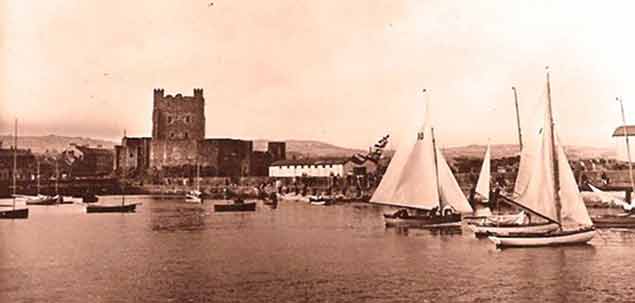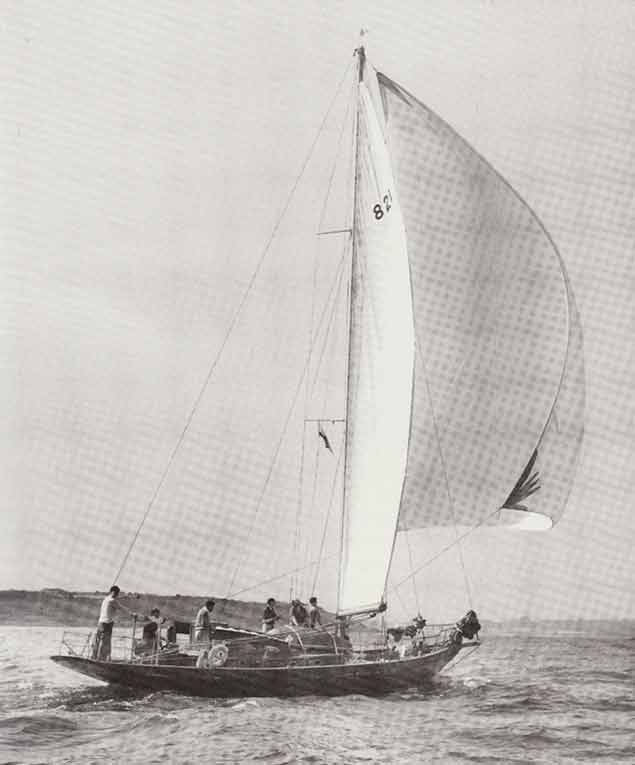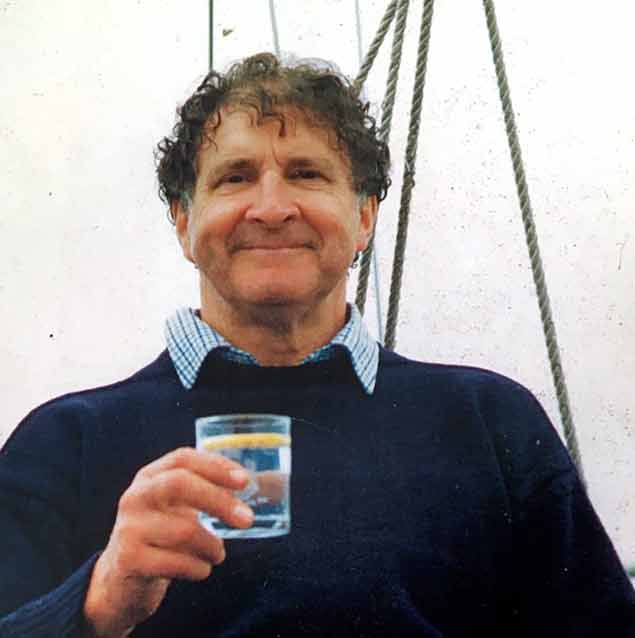Hugh Kennedy’s eighty-five years of well-lived life successfully combined so many aspects of Irish sailing, and indeed Irish life generally, that we have to keep reminding ourselves that it was just one man who so ably filled such a variety of roles afloat and ashore in so many locations.
Not that he was one man alone, doing things in solitary style. On the contrary, he was very much the family man, and happily gregarious with it, while at the same time being a significant administrative and social asset to the many organizations and clubs with which he became closely involved.
One of three sons of Frank Kennedy, a distinguished Belfast gynaecologist, his early childhood in the 1930s was spent in the family home in the Queen’s University area, where Hugh and his brother Joe were later to live in adult life. But his mother’s people, the Magees – who in the distant past had been the Magees of Islandmagee, the peninsula to the east of Larne Lough – had property in Carrickfergus and Whitehead on the north shore of Belfast Lough. When World War II of 1939 to 1945 invaded Belfast with its episodes of bombing blitz, the young Kennedy boys were evacuated from the city to stay with aunts in Whitehead.
It was there that they’d already had their first taste of sailing with the County Antrim Yacht Club, and Hugh was so taken with it that he worked on detailed plans to turn a family kayak into a sailing boat. However, he was also encouraged in sailing in some local dinghies, and then in 1948 when he was 16, the brothers combined resources to buy Rowena, an able keelboat of the 18ft Waverley Class which had been the backbone of Whitehead sailing since 1903.
 The Kennedy brothers’ Waverley Class Rowena (no 1, right) in Carrickfergus Harbour for a regatta in the late 1940s. Their mother’s family, the Magees, had property in the town and in nearby Whitehead, and were originally the Magees of the peninsula of Islandmagee
The Kennedy brothers’ Waverley Class Rowena (no 1, right) in Carrickfergus Harbour for a regatta in the late 1940s. Their mother’s family, the Magees, had property in the town and in nearby Whitehead, and were originally the Magees of the peninsula of Islandmagee
Despite their relative youth, they’d very soon got the measure of the class, and Rowena in their ownership continued as one of Belfast Lough’s most successful boats. But the Kennedy boys were keen for a new challenge in sailing, and by the 1950s Hugh was one of the stars on the rapidly-growing GP14 dinghy circuit in Northern Ireland.
He was also a rising star in legal circles as a promising barrister, and he cut quite a dash in his bachelor days. The GP 14s with their readiness to trailer-sail were setting a stylish pace, and Hugh Kennedy with his successful GP14 Tosca towed behind his distinctive black MG saloon car definitely brought a bit of something special to any event he attended.
At the same time he was taking his first steps in offshore racing with Frank and Eric Hopkirk aboard the up-dated 17-ton cutter Glance, which belied her build-date of 1894 with a masthead Bermudan cutter rig worthy of John Illingworth himself. While the name of Hopkirk was later to be better known through their younger brother Paddy, who was to achieve international renown at the top level of car rallying, in the 1950s it was Frank and Eric Hopkirk who spread the name of Belfast Lough sailing with Glance, competing on the Royal Ocean Racing Club circuit.
 Frank and Eric Hopkirk’s veteran cutter Glance (RUYC) at the start of the 1953 Fastnet Race, in which she won the Jolie Brise Cup.
Frank and Eric Hopkirk’s veteran cutter Glance (RUYC) at the start of the 1953 Fastnet Race, in which she won the Jolie Brise Cup.
The barristers of Belfast provided a ready recruiting ground for the crewing needs of Glance, and Hugh Kennedy was particularly welcomed aboard as his helming skills gave the old cutter previously unsuspected levels of performance. He in turn was rewarded by sailing many offshore miles, including one of the RORC races to Spain which were a regular feature of non-Fastnet years. This experience so imbued him with a love for everything Spanish that when he moved into offshore racer ownership himself, his spinnakers were invariably in the national colours of Spain.
On the rapidly-expanding dinghy scene in Ireland, he’d soon outgrown the GP 14s, and was one of that elite band from every main sailing centre in Ireland which moved into the International 505 Class. This wonderful group thrived mightily as a hugely competitive circuit for maybe a dozen years, and racing against helmsmen and crew of the calibre of Clayton Love Jnr, Barry Bramwell, John McCleary, Simon Haselden, Sean Flood, Joe Woodward, Johnny Hooper, Peter Gray, Neil Hegarty and many other formidable talents, Hugh Kennedy was in his element and frequently in the frame.
 The International 505. In the 1960s, they were the undisputed aristocrats of Irish dinghy sailing, and Hugh Kennedy was one of the stars.
The International 505. In the 1960s, they were the undisputed aristocrats of Irish dinghy sailing, and Hugh Kennedy was one of the stars.
While the 505 circus took the class to many parts of Ireland, for Hugh Kennedy it was Baltimore in West Cork which became a favoured spot after the Irish Dinghy Racing Association’s annual Dinghy Week was staged there in 1961 and 1964, and enjoyment was crowned with racing success at the top level. Meanwhile he continued offshore racing when possible, and cruising too, such that he was elected to the Irish Cruising Club in 1963. As for the scene at home on Belfast Lough, he found the racing atmosphere at Ballyholme Bay the most congenial and he made it his home sailing base, in due course becoming Commodore of Ballyholme Yacht Club.
But in high summer if not offshore racing with skippers like Darty Glover on Tyrena, he seemed to be drawn to Baltimore, and there in 1965 he met Aoife Hegarty, the sister of Neil Hegarty, and the already complex matrix of Kennedy family life in the north was now enmeshed with the even more complex Cork-Baltimore multi-family pattern.
Among other things, being married to Aoife with a growing family meant that Hugh was now included in that most distinguished of crew panels, the lineup for Denis Doyle’s succession of keenly-campaigned Moondusters. Somehow life was organised around summers in Baltimore with the rest of the year in Belfast, and while in time Hugh Kennedy was a Commodore of Baltimore Sailing Club, he was still sailing on Belfast Lough and had taken on extra duties as a flag officer of the Royal Ulster Yacht Club.
 Steering a delicate line…..Hugh Kennedy at the helm of his 35-footer Tosca IV, sailing in lively conditions towards the coast of Brittany to lead a Cruise-in-Company of the Irish Cruising Club in 1992. As a flag officer at various times of Ballyholme YC, Royal Ulster YC, Baltimore SC, and the Irish Cruising Club, he had to tread a delicate line in flag etiquette, but not everyone noticed that he also flew the national colours of Spain with his spinnakers. Photo ICC
Steering a delicate line…..Hugh Kennedy at the helm of his 35-footer Tosca IV, sailing in lively conditions towards the coast of Brittany to lead a Cruise-in-Company of the Irish Cruising Club in 1992. As a flag officer at various times of Ballyholme YC, Royal Ulster YC, Baltimore SC, and the Irish Cruising Club, he had to tread a delicate line in flag etiquette, but not everyone noticed that he also flew the national colours of Spain with his spinnakers. Photo ICC
After decades of devotion to dinghy ownership and racing, he finally moved into keelboat cruising and racing, first with the Charles A Nicholson-designed Jolina Class 35-footer Tosca IV, and then with the Sparkman & Stephens-designed She 36 Tosca V.
Naturally his administrative talents were also spotted by fellow cruiser owners and in 1990-1993 he was elected Commodore of the Irish Cruising Club, leading a successful Cruise-in-Company to Brittany with a flourish. It was all part of a lifestyle which was the living embodiment of the old saying that if you want anything done, then ask a busy man to do it.
 Job done. Hugh Kennedy celebrates after two successful years as Irish Cruising Club Commodore. Photo courtesy Kennedy family
Job done. Hugh Kennedy celebrates after two successful years as Irish Cruising Club Commodore. Photo courtesy Kennedy family
Quite how the Kennedy family maintained the pace of being in the heart of things in Belfast, Baltimore and Cork, and more recently Dublin too, is beyond most people’s imagining. Yet somehow Hugh Kennedy had time for everyone who shared his interests, wherever he might be. Our thoughts and heartfelt condolences are with his family at this time of loss. The world is a better place for Hugh Kennedy having been in it.
WMN
 The shapely transom of Tosca IV revealed just some of Hugh Kennedy’s many club affiliations. Photo courtesy Kennedy family
The shapely transom of Tosca IV revealed just some of Hugh Kennedy’s many club affiliations. Photo courtesy Kennedy family































































